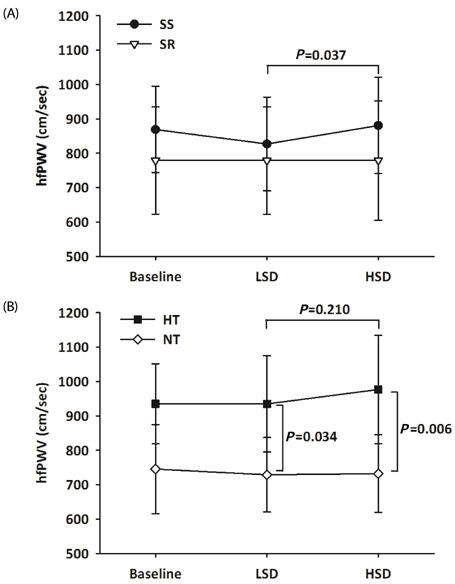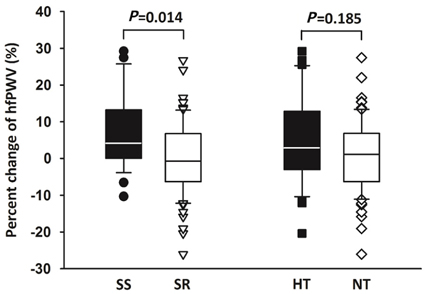Nutr Res Pract.
2016 Jun;10(3):288-293. 10.4162/nrp.2016.10.3.288.
Elevation of heart-femoral pulse wave velocity by short-term low sodium diet followed by high sodium diet in hypertensive patients with sodium sensitivity
- Affiliations
-
- 1Cardiovascular Center, Dongguk University Ilsan Hospital, 27 Dongguk-ro, Ilsandong-gu, Goyang 10326, Korea. mooyong_rhee@dumc.or.kr
- 2Emergency Medicine and Cardiology, Emergency Medical Center, Department of Internal Medicine, Seoul National University Hospital, Seoul 03080, Korea.
- 3Division of Cardiology, Department of Internal Medicine, College of Medicine, Dongguk University, Gyeongju 38067, Korea.
- 4Department of Clinical Pharmacology and Therapeutics, Dongguk University Ilsan Hospital, Goyang 10326, Korea.
- 5Department of Health Policy and Management, College of Health Science & Department of Public Health Science, Graduate School, Korea University, Seoul 02841, Korea.
- KMID: 2342131
- DOI: http://doi.org/10.4162/nrp.2016.10.3.288
Abstract
- BACKGROUND/OBJECTIVES
We compared changes in heart-femoral pulse wave velocity (hfPWV) in response to low sodium and high sodium diet between individuals with sodium sensitivity (SS) and resistance (SR) to evaluate the influence of sodium intake on arterial stiffness.
SUBJECTS/METHODS
Thirty-one hypertensive and 70 normotensive individuals were given 7 days of low sodium dietary approach to stop hypertension (DASH) diet (LSD, 100 mmol NaCl/day) followed by 7 days of high sodium DASH diet (HSD, 300 mmol NaCl/day) during 2 weeks of hospitalization. The hfPWV was measured and compared after the LSD and HSD.
RESULTS
The hfPWV was significantly elevated from LSD to HSD in individuals with SS (P = 0.001) independently of changes in mean arterial pressure (P = 0.037). Conversely, there was no significant elevation of hfPWV from LSD to HSD in individuals with SR. The percent change in hfPWV from the LSD to the HSD in individuals with SS was higher than that in individuals with SR. Subgroup analysis revealed that individuals with both SS and hypertension showed significant elevation of hfPWV from LSD to HSD upon adjusted analysis using changes of the means arterial pressure (P = 0.040). However, there was no significant elevation of hfPWV in individuals with SS and normotension.
CONCLUSION
High sodium intake elevated hfPWV in hypertensive individuals with SS, suggesting that high sodium intake increases aortic stiffness, and may contribute to enhanced cardiovascular risk in hypertensive individuals with SS.
Keyword
MeSH Terms
Figure
Cited by 1 articles
-
Antihypertensive effect of Ganjang (traditional Korean soy sauce) on Sprague-Dawley Rats
Eun-Gyung Mun, Hee-Sook Sohn, Mi-Sun Kim, Youn-Soo Cha
Nutr Res Pract. 2017;11(5):388-395. doi: 10.4162/nrp.2017.11.5.388.
Reference
-
1. He FJ, MacGregor GA. A comprehensive review on salt and health and current experience of worldwide salt reduction programmes. J Hum Hypertens. 2009; 23:363–384.
Article2. Blacher J, Guerin AP, Pannier B, Marchais SJ, Safar ME, London GM. Impact of aortic stiffness on survival in end-stage renal disease. Circulation. 1999; 99:2434–2439.
Article3. Laurent S, Boutouyrie P, Asmar R, Gautier I, Laloux B, Guize L, Ducimetiere P, Benetos A. Aortic stiffness is an independent predictor of all-cause and cardiovascular mortality in hypertensive patients. Hypertension. 2001; 37:1236–1241.
Article4. Laurent S, Katsahian S, Fassot C, Tropeano AI, Gautier I, Laloux B, Boutouyrie P. Aortic stiffness is an independent predictor of fatal stroke in essential hypertension. Stroke. 2003; 34:1203–1206.
Article5. Willum-Hansen T, Staessen JA, Torp-Pedersen C, Rasmussen S, Thijs L, Ibsen H, Jeppesen J. Prognostic value of aortic pulse wave velocity as index of arterial stiffness in the general population. Circulation. 2006; 113:664–670.
Article6. Laurent S, Alivon M, Beaussier H, Boutouyrie P. Aortic stiffness as a tissue biomarker for predicting future cardiovascular events in asymptomatic hypertensive subjects. Ann Med. 2012; 44:Suppl 1. S93–S97.
Article7. Safar ME, London GM, Plante GE. Arterial stiffness and kidney function. Hypertension. 2004; 43:163–168.
Article8. Aatola H, Hutri-Kähönen N, Juonala M, Viikari JS, Hulkkonen J, Laitinen T, Taittonen L, Lehtimäki T, Raitakari OT, Kähönen M. Lifetime risk factors and arterial pulse wave velocity in adulthood: the cardiovascular risk in young Finns study. Hypertension. 2010; 55:806–811.
Article9. Kaess BM, Rong J, Larson MG, Hamburg NM, Vita JA, Levy D, Benjamin EJ, Vasan RS, Mitchell GF. Aortic stiffness, blood pressure progression, and incident hypertension. JAMA. 2012; 308:875–881.
Article10. Najjar SS, Scuteri A, Shetty V, Wright JG, Muller DC, Fleg JL, Spurgeon HP, Ferrucci L, Lakatta EG. Pulse wave velocity is an independent predictor of the longitudinal increase in systolic blood pressure and of incident hypertension in the Baltimore Longitudinal Study of Aging. J Am Coll Cardiol. 2008; 51:1377–1383.
Article11. Todd AS, Macginley RJ, Schollum JB, Johnson RJ, Williams SM, Sutherland WH, Mann JI, Walker RJ. Dietary salt loading impairs arterial vascular reactivity. Am J Clin Nutr. 2010; 91:557–564.
Article12. Avolio AP, Clyde KM, Beard TC, Cooke HM, Ho KK, O'Rourke MF. Improved arterial distensibility in normotensive subjects on a low salt diet. Arteriosclerosis. 1986; 6:166–169.
Article13. Todd AS, Macginley RJ, Schollum JB, Williams SM, Sutherland WH, Mann JI, Walker RJ. Dietary sodium loading in normotensive healthy volunteers does not increase arterial vascular reactivity or blood pressure. Nephrology (Carlton). 2012; 17:249–256.
Article14. Shin SJ, Lim CY, Rhee MY, Oh SW, Na SH, Park Y, Kim CI, Kim SY, Kim JW, Park HK. Characteristics of sodium sensitivity in Korean populations. J Korean Med Sci. 2011; 26:1061–1067.
Article15. Rhee MY, Lim CY, Shin SJ, Oh SW, Park YS, Kim JW, Park HK, Kim CI, Park CY, Kim SW. Elevation of morning blood pressure in sodium resistant subjects by high sodium diet. J Korean Med Sci. 2013; 28:555–563.
Article16. Rhee MY, Yang SJ, Oh SW, Park Y, Kim CI, Park HK, Park SW, Park CY. Novel genetic variations associated with salt sensitivity in the Korean population. Hypertens Res. 2011; 34:606–611.
Article17. Mancia G, Fagard R, Narkiewicz K, Redón J, Zanchetti A, Böhm M, Christiaens T, Cifkova R, De Backer G, Dominiczak A, Galderisi M, Grobbee DE, Jaarsma T, Kirchhof P, Kjeldsen SE, Laurent S, Manolis AJ, Nilsson PM, Ruilope LM, Schmieder RE, Sirnes PA, Sleight P, Viigimaa M, Waeber B, Zannad F. Task Force Members. 2013 ESH/ESC Guidelines for the management of arterial hypertension: the Task Force for the management of arterial hypertension of the European Society of Hypertension (ESH) and of the European Society of Cardiology (ESC). J Hypertens. 2013; 31:1281–1357.18. Rhee MY, Na SH, Kim YK, Lee MM, Kim HY. Acute effects of cigarette smoking on arterial stiffness and blood pressure in male smokers with hypertension. Am J Hypertens. 2007; 20:637–641.
Article19. Nah DY, Lee CG, Bae JH, Chung JW, Rhee MY, Kim JH, Kim YS, Kim YK, Lee MM. Subclinical renal insufficiency range of estimated glomerular filtration rate and microalbuminuria are independently associated with increased arterial stiffness in never treated hypertensives. Korean Circ J. 2013; 43:255–260.
Article20. Oliver JJ, Webb DJ. Noninvasive assessment of arterial stiffness and risk of atherosclerotic events. Arterioscler Thromb Vasc Biol. 2003; 23:554–566.
Article21. Gates PE, Tanaka H, Hiatt WR, Seals DR. Dietary sodium restriction rapidly improves large elastic artery compliance in older adults with systolic hypertension. Hypertension. 2004; 44:35–41.
Article22. He FJ, Marciniak M, Visagie E, Markandu ND, Anand V, Dalton RN, MacGregor GA. Effect of modest salt reduction on blood pressure, urinary albumin, and pulse wave velocity in white, black, and Asian mild hypertensives. Hypertension. 2009; 54:482–488.
Article23. Liu Z, Peng J, Lu F, Zhao Y, Wang S, Sun S, Zhang H, Diao Y. Salt loading and potassium supplementation: effects on ambulatory arterial stiffness index and endothelin-1 levels in normotensive and mild hypertensive patients. J Clin Hypertens (Greenwich). 2013; 15:485–496.
Article24. Sullivan JM, Ratts TE. Sodium sensitivity in human subjects. Hemodynamic and hormonal correlates. Hypertension. 1988; 11:717–723.
Article25. Weinberger MH, Miller JZ, Luft FC, Grim CE, Fineberg NS. Definitions and characteristics of sodium sensitivity and blood pressure resistance. Hypertension. 1986; 8:II127–II134.
Article26. Dickinson KM, Keogh JB, Clifton PM. Effects of a low-salt diet on flow-mediated dilatation in humans. Am J Clin Nutr. 2009; 89:485–490.
Article27. Avolio A, Jones D, Tafazzoli-Shadpour M. Quantification of alterations in structure and function of elastin in the arterial media. Hypertension. 1998; 32:170–175.
Article28. Bank AJ, Wang H, Holte JE, Mullen K, Shammas R, Kubo SH. Contribution of collagen, elastin, and smooth muscle to in vivo human brachial artery wall stress and elastic modulus. Circulation. 1996; 94:3263–3270.
Article29. Kinlay S, Creager MA, Fukumoto M, Hikita H, Fang JC, Selwyn AP, Ganz P. Endothelium-derived nitric oxide regulates arterial elasticity in human arteries in vivo. Hypertension. 2001; 38:1049–1053.
Article30. Safar ME, Benetos A. Factors influencing arterial stiffness in systolic hypertension in the elderly: role of sodium and the renin-angiotensin system. Am J Hypertens. 2003; 16:249–258.
Article31. Boegehold MA. The effect of high salt intake on endothelial function: reduced vascular nitric oxide in the absence of hypertension. J Vasc Res. 2013; 50:458–467.
Article32. Akita S, Sacks FM, Svetkey LP, Conlin PR, Kimura G. DASH-Sodium Trial Collaborative Research Group. Effects of the Dietary Approaches to Stop Hypertension (DASH) diet on the pressure-natriuresis relationship. Hypertension. 2003; 42:8–13.
Article
- Full Text Links
- Actions
-
Cited
- CITED
-
- Close
- Share
- Similar articles
-
- The Comparison of Renal Handling of Sodium and Potassium According to Salt Intake between Control and Hypertensive Group
- Effect of low sodium and high potassium diet on lowering blood pressure
- Some Effects of High and Low Sodium Intake on a Vegetarian Diet in Rats
- Customers' Perceptions of Operational Status of and Needs for Sodium Reduction in the Industry Foodservice in Seoul
- Study on Sodium and Potassium Contents of Foods Produced in Korea



